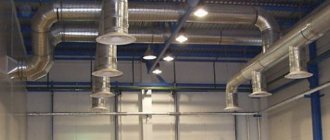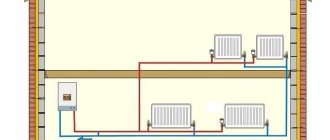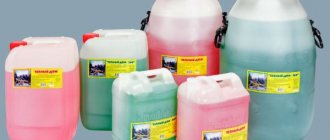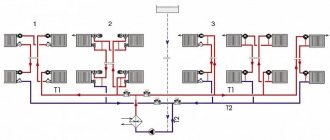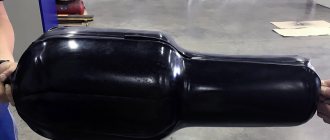- Room characteristics
- Thermal insulation of warehouses and hangars
- Warehouse heating methods
- Air heating systems
- Radiant heating systems
- Air-thermal curtains
- Water infrared panels
Send a quick request Heating warehouses, hangars, storage facilities and other similar buildings differs significantly from heating, say, residential buildings - both the overall dimensions of the room and the special requirements for the conditions of the internal microclimate play an important role.
INTECH-Climate is ready to implement professional solutions for climate control and other engineering equipment. We will carry out a full cycle of turnkey work: design, selection, delivery, installation and maintenance. Call now: +7 (495) 146-65-64
. Submit your application
In particular, it is usually not necessary to heat the entire warehouse, but only certain work areas and cargo storage areas, and the temperature and humidity levels in such areas can be completely different. In this regard, the issue of heating a warehouse must be approached with maximum responsibility - in order to be able to fully use the functionality of the premises.
Standard water heating, with which any of us are familiar, is of little use for heating air in such a spacious room - the heated air masses will simply rise upward into areas that are not in any way used. Accordingly, costs will increase significantly - with minimal useful returns. So, which warehouse heating system should you use?
Room characteristics
When choosing a heating system, you should pay attention to some characteristics of the building. First of all, it is necessary to take into account the height of the ceiling and the area of the building. If the height from floor to ceiling is more than 3 m, then it is not recommended to use water systems, because they are unable to provide the required temperature in large rooms.
The second important indicator is thermal insulation. Insulated walls and ceilings will significantly save money spent on heating a workshop or warehouse. If it is not possible to avoid heat loss, it is recommended to use heat sources that heat certain work areas.
You should also take into account the technological temperature requirements for storing raw materials or products.
So what should you choose - a fan heater or a heater?
Industrial use
Proper room ventilation is of paramount importance not only for the health and comfort of employees, but also for the microclimate of the work area. This is especially true in places with insufficient air exchange, due to the absence or small number of windows. For example, in open offices with a large number of employees in one room, shopping centers, warehouses, agricultural greenhouses, production workshops, auto repair shops, and laboratories. In such cases, powerful water fan heaters designed for industrial facilities are installed.
The industrial use of heaters is much wider than that of fan heaters. They are often used to dry out new buildings, on large surfaces where it is impossible to install a heating system.
The use of heaters in industry helps to provide heat in logistics centers, production workshops, warehouses, commercial and industrial premises. Industrial heaters are durable due to their metal casing. The durability of the equipment guarantees many years of service and ensures reliable and continuous operation of the system, in accordance with the needs of the user.
Home use
Small, home fan heaters are an excellent choice for people who want to raise the air temperature only in their room or in a specific area. A fan will be an excellent solution to this problem. It can not only complement the central heating system, but also become the main source of heat in the cool season.
The design of home heat fans can be quite modern, minimalist and very elegant. Heaters are often more expensive, but are more effective at heating living spaces. However, a lot depends on the size of the room you want to heat.
If you want to warm up a small room, there is no point in buying a heater - an inexpensive heater will suffice.
Thermal insulation of warehouses and hangars
A building made of brick, blocks or concrete, or a metal hangar can serve as a storage facility. If in the first case insulation is not always required, then thermal insulation of the hangar is simply necessary. Without this, it will be cold in winter, and very hot in summer, even hotter than outside.
Heating of the hangar should be done only after high-quality insulation, since the main task of heating is to replenish heat loss. The less heat loss, the cheaper heating costs. Therefore, you need to carefully select the material according to its characteristics and correctly calculate the insulation layer.
As a rule, warehouses are insulated from the inside. Speed of work is of great importance. The price of the event is also important. What parameters should the thermal insulation layer meet:
- minimal thermal conductivity;
- non-flammability;
- moisture resistance;
- speed of application;
- operation without finishing.
The lack of finishing will not affect the operation of the warehouse in any way; beauty is not needed here, the main thing is practicality and reliability.
Taking into account all the above parameters, thermal insulation of a warehouse with polyurethane foam would be an ideal option.
PPU is a polymer insulation with a closed-cell structure, and for a hangar, foamed polyurethane foam is generally the only option. It has the lowest thermal conductivity coefficient compared to all modern insulation materials, which is 0.029 W/m*C. It does not allow steam to pass through and does not absorb moisture. The material does not burn, even if an open flame is directed at it, and therefore does not emit toxic gases. Polyurethane foam has high adhesion to almost all materials, that is, it holds tightly to any surface. The insulation is lightweight, does not shrink, and is not afraid of rodents.
Thermal insulation of a polyurethane foam warehouse is carried out in one day, depending on the area, but often no more than a day. The insulation is applied by spraying, using a special blow molding machine. No one carries out such work with their own hands; they hire contractors.
Autonomous gas heating of apartments is the norm for new buildings today. It's really very convenient.
Using a smart home system, heating is controlled remotely; all you need is the Internet.
Pressure water
| Pipe diameter | Wall thickness | Price for 1 p.m. VAT included |
| TU 6-49-53883187-01-05 SDR 17 | ||
| 16 t | 2 | 13,75 |
| 20 t | 2 | 16,82 |
| 25 s | 2 | 21,46 |
| 32 s | 2,3 | 31,61 |
| 40 s | 2,4 | 41,76 |
| 50 s | 3 | 65,25 |
| 63 s | 3,8 | 103,96 |
| 110 s | 6,6 | 291,82 |
| 160 s | 9,5 | 608,82 |
| 225 s | 13,4 | 1206,46 |
| 315 s | 18,7 | 2349,49 |
| 400 s | 24 | 4114,22 |
Pressure water
Warehouse heating methods
The following heating systems are used to heat the air in a warehouse:
- centralized water;
- air;
- radiant.
In the first case, heating occurs due to hot water moving through a system of water pipes and heating the radiators. The water comes from the central heating system; Depending on the storage conditions, heating is possible in the boiler room, if there is one, as well as when using special electrical appliances.
Only used in small warehouses with low ceilings due to the reasons already described above; Also, this system is not very popular due to the complexity of installation, as well as the large amount of space occupied, which does not allow the warehouse area to be used with maximum efficiency (this mainly applies to retail warehouses and bases where rack structures are used).
Air heating systems
Much more popular is air heating of a warehouse, which first began to be used back in the seventies of the last century and is being effectively improved to this day. These systems do not interact with any external sources, and heating of the air in the room is ensured by the operation of heat generators and air heaters - water and steam.
The heated air flows through box-shaped collectors into those rooms where it is necessary to maintain a certain temperature regime. To reduce or increase the air flow, special adjustable shutters or blinds are used.
This method also has some disadvantages, although they are fewer than the previous system. However, the air system is one of the most commonly used in warehouse heating due to its ease of installation and relatively low equipment cost.
Results
Without warehouse insulation, no heating system will be effective. The best insulation is polyurethane foam (PPU). There are three heating options for the warehouse: air, electric, water. Air heating with heat pumps is convenient, it makes it possible to control air temperature and humidity, and circulation speed. The disadvantage is high initial costs. Electric heating is expensive to operate, but the devices can be moved to any other place. Water systems are a classic and are the most common.
We are a professional engineering design and installation company. On our website you can receive a commercial offer and find the necessary information.
Warehouse or hangar heating is provided by EuroHolod with turnkey installation. For questions related to heating, call +7(495) 745-01-41.
To receive a commercial offer
, write a request to e-mail [email protected] or send a quick request
See below
- Heating systems. Heat supply for buildings
- What is your object?
Radiant heating systems
Radiant heating is even more economical and simple to install and use than air heating. The operation of infrared heaters does not contribute to the generation of dust, and also does not dry out the air. The principle of operation of such a system is extremely simple - like the rays of the sun, the elements of this system heat not the air, but the objects at which they are directed - the floor, walls, objects - and they, in turn, give off part of the received heat to the environment.
This is most convenient in cases where heating of a certain small area is required; The lamps themselves can be easily mounted at a height of 1.5-2 meters from the floor, and the concentration of released thermal particles can be adjusted.
Depending on the microclimate maintained inside the warehouse, “light” and “dark” infrared heaters are used. The release of heat in them is facilitated by natural or liquefied gas. Heaters can either be mounted directly into walls or wall niches, or be part of entire radiant panels located along the entire length of the building. Portable models are also available for use when it is impossible to install a heating system. Depending on the dimensions, they can be either manual or placed on special wheeled units.
“Light” infrared heaters are characterized by extremely high temperatures - the surface of the burner can heat up to 900 degrees. “Dark” ones provide less heating - only up to 500 degrees - but at the same time they are equipped with special reflectors that allow the dissipation of thermal particles and, thereby, provide heating of much larger areas. They also differ in design - the first are a solid ceramic tile (its heating produces infrared radiation), while the second are a pipe structure with an external heat-resistant coating, inside which the gas combustion process takes place.
The most versatile type of infrared heaters are radiant panels, which are widespread in most standard storage warehouses and meet standard fire safety standards. They are also convenient to use for air conditioning - when connecting a steam generator. In this case, the steam can heat up to almost 200 degrees, which contributes to a significant increase in the air exchange rate indoors.
Thus, we can say that today radiant heaters of both types represent the best options for heating systems - productive, economical and convenient. However, the following restrictions on the use of these units should be mentioned:
- impossibility of using heating panels at a height below 4 meters. Otherwise, the heating temperature of the area will be too high - in addition, such intense radiation will have a bad effect on the health of people passing under them;
- in rooms with increased fire safety requirements. This applies to warehouses of fuels and lubricants and other flammable liquids, petroleum products, oils, etc.;
- in rooms where goods sensitive to infrared radiation are stored.
Technical standards
Various SNiP, PPB and PUE regulate the rules for installing heating systems in warehouses, but only a specialist can understand the jungle of technical terminology. Here are some excerpts from the regulations:
- SNiP 2.11.01-85 clause 5.3 states that in warehouses it is allowed to install air heating or combine air heating with local heating devices.
- PUE clause 7.4.25: if in a fire hazardous area of any class (which includes warehouses) heating is possible only with the help of electric heating devices, then heated surfaces must be protected from contact with flammable substances. A stand made of non-combustible material must be installed under the devices. For protection, fireproof screens are used that do not transmit thermal radiation. It is prohibited to use electric heating devices in fire hazardous areas of warehouses, museums, archives, libraries, etc. The exception is specially designated premises, for example, a dining room.
- SNiP 41-01-2003 clause 7.9.1. It is not allowed to place heating equipment in serviced warehouses of categories A, B, B1-B4. In terminals of categories B2, B3, B4, it is possible to place heating equipment subject to several conditions: the warehouse premises must be equipped with an automatic fire alarm, which can turn off the equipment in the event of a fire.
- heating devices must have a degree of protection not lower than IP-54;
- SNiP 41-01-2003 clause 12.2. Electrical receivers for heating systems must be of the same category as electrical receivers for engineering and technological equipment of the warehouse.
In general, all standards speak about the installation of gas heating for warehouses, but the use of electrical equipment is also allowed. The electric boiler must be installed in a separate room or annex with walls made of non-combustible materials.
Air-thermal curtains
Air curtains are necessary to separate zones with different temperature conditions. The equipment is mounted in the opening of doors, windows, gates. The curtain is formed as a result of the movement of high-speed air flow. This is a kind of invisible barrier that does not allow warm air to escape and does not allow cold air from outside to enter. In addition, the air curtain isolates the warehouse from exhaust gases, dust and other negative phenomena without interfering with the movement of special vehicles.
The width of the curtain is 0.6-2.5 meters. In wider openings, several devices are mounted close to each other. When calculating a thermal curtain, the following factors are taken into account:
- maximum supply air temperature 50 °C at the entrance;
- outside air temperature 5-14 °C;
- air speed is no more than 8 m/s at the entrance and no more than 25 m/s at technological openings and gates;
- installation of thermal curtains is justified for entrance doors without vestibules that open five or more times a day or for 40 minutes per shift.
Steam systems
The coolant is dry saturated steam with a temperature of no more than 130 °C. The system can be open, when the condensate is transferred to the heat exchanger by a pump, or closed, when the condensate moves by gravity. Main advantages:
- minimal heat loss in heat exchangers;
- rapid heating of radiators and other heating devices;
- low inertia;
- possibility of heating multi-storey buildings;
- compactness of equipment;
- low hydrostatic pressure in the system.
Flaws:
- high heat losses in steam pipelines, as a result - a decrease in efficiency;
- noisiness;
- it is impossible to make the coolant temperature below 100 °C;
- intense corrosion of metal circuit elements.
Steam heating is permitted for terminals with non-flammable and non-toxic dust, non-flammable and non-combustible vapors and gases. Steam lines are installed separately from the ventilation and air conditioning system.
Types of heating systems
There are several types of modern heating systems that can quickly and efficiently provide a warehouse, workshop or hangar with heat. All of them must meet several criteria: fire safety, high power, efficiency. A detailed description of the advantages and disadvantages of heat supply systems will help you make the right choice.
Steam
Water vapor is used as a heat source. Do not use in areas where flammable gases or vapors may be released. The main advantages of this method are:
- quick heating of the heating main;
- compactness of equipment;
- low pressure in the heating network;
- insignificant heat losses in heat exchangers.
However, heating a warehouse with steam also has significant disadvantages:
- pipelines are susceptible to corrosion;
- the coolant temperature must be at least 100° C;
- large heat losses in pipes.
Water
The best option for small industrial buildings with an area of up to 250 m². This is how woodworking shop heating is most often done. Firstly, water heating ensures uniform heating of the entire workshop space and maintains a constant air temperature, which is very important for a material such as wood.
Water heating.
Secondly, waste from the wood processing industry can be used as a fuel material. In addition, the system allows you to organize hot water supply if necessary. But there are also negative points:
- for maximum heating you need to use pipes of large diameters;
- the air in the room warms up slowly;
- complex and expensive installation.
Air
It is a network of branched channels through which heated air moves. Air heating of the workshop occurs as follows.
Through special equipment, including filters and fans, outside air is taken in. The incoming air masses are heated in a special electric or gas installation. Next, the hot air is distributed throughout all working areas of the building using an extensive duct system. The system has gained high popularity due to its advantages:
- absence of radiators and coolant, which significantly reduces heat loss;
- Efficiency – up to 95%;
- compatibility of the heating circuit with the ventilation circuit;
- possibility of adjusting the temperature regime.
Water infrared panels
Today, there is another very profitable method by which you can arrange the heating of a hangar or any other large utility room - the use of IR water panels.
In this case, the coolant fluid is heated to 160 °C and enters radiant tubes located under the ceiling. The infrared emitter effectively dissipates heat throughout the entire volume of the heated room. Thus, the equipment operates not on a convective, but on a radiant principle.
The uniqueness of such equipment is that the air in the room does not heat up. Various types of surfaces are subject to heating, including the surface of equipment, goods, shelving, walls, floors, ceilings and even people in the room.
Using IR water panels, you can effectively organize the heating of a workshop in which welding, carpentry and other production work is carried out.
In this case, the purpose of the method is not to heat the room or raw materials itself, but to provide heat to the working personnel.
